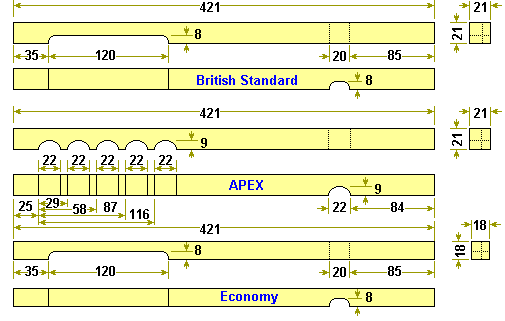
The Grain should run along the longest dimension of these parts and should be straight.
Any type of wood will suffice for entrance blocks, but hardwoods are more durable and may warp less, I personally prefer hardwood for this bee hive component.
In some parts of the world the term 'entrance reducer' is used to mean the same item as is called here an 'entrance block'. However the entrance reducers on the page linked above left are special types that I have used with floors having hinged flaps as entrances.

The Grain should run along the longest dimension of these parts and should be straight.
Any type of wood will suffice for entrance blocks, but hardwoods are more durable and may warp less, I personally prefer hardwood for this bee hive component.

The items as drawn at right are made more durable if they are soaked in
linseed oil
and then when dry have
petroleum jelly
rubbed into all surfaces, this will ensure a lifetime of use.

Special block for use with "Sundown" floor. This entrance block can be fitted in different ways to block the entrance, allow a 9 mm entrance or can be removed completely to provide an 18 mm entrance. Owing to it's thin cross section this sort of block is best made from hardwood to reduce distortion due to warping.
During the 2000 season (and ever since) robbing by wasps has seemed more intense, and entrance notches of 9 mm x 9 mm had to be used by several beekeepers local to me. I used some with a single 10 mm diameter drilled holes for full sized hives.
The use of 10 mm diameter entrance holes was extended to entrance blocks used for five frame nucs and baby nucs (which used the same size block) the two illustrations below show a couple of types, one of which has a single conventional curved notch as an entrance and the other has a single 10 mm diameter hole.


You will notice various other holes in these enhtrance blocks, which are square in cross section and can be installed as an entrance or used to block the hive entrance. When in the blocking position a small amount of air can feed through the eight x 4 mm holes grouped in two groups of four near the centre of the entrance block. The four holes near the outer ends of the block are 5 mm in diameter and are countersunk to accept fixing screws. The screws themselves being placed using an electric screwdriver carried into the apiary for that purpose.
Dimensions of these five frame nuc entrance blocks, were 191 mm long x 21 mm x 21 mm, they were made hundreds at a time, using drilling jigs. The reason 21 mm was chosen as the thickness is that the floor side rails were 22 mm and the floors were also screwed to the nuc boxes (there was a security problem at the breeding apiary). the blocks being a whole millimetre narrower could never be trapped by the screwing action. Such trapping would have been a nuisance if you needed to change a block form one position to the other.
The entrance blocks were also identified by branding and you will note a couple of numbers engraved into the wood surface, these are inventory numbers and have been generated using the method shown at the bottom of the linked page.